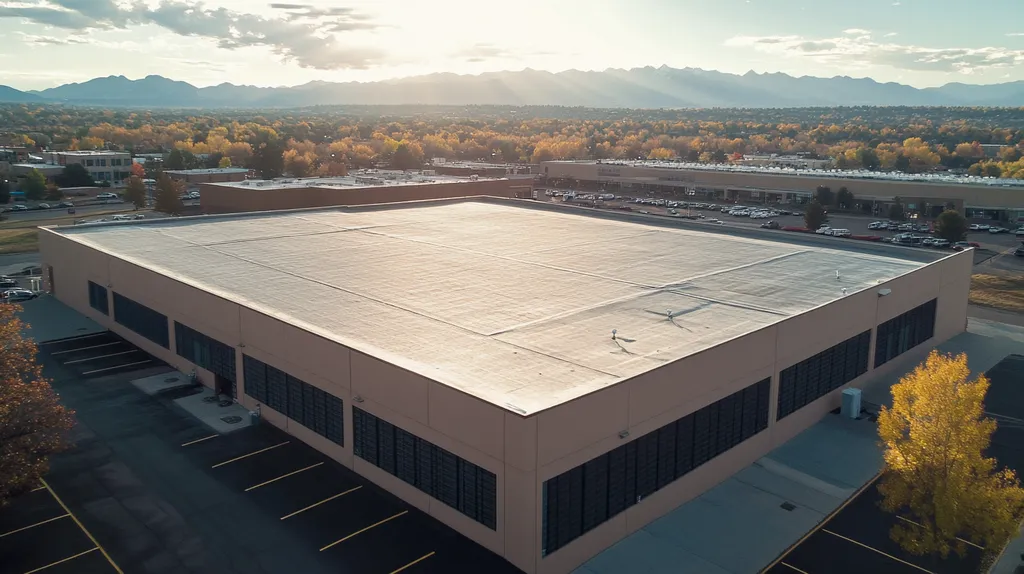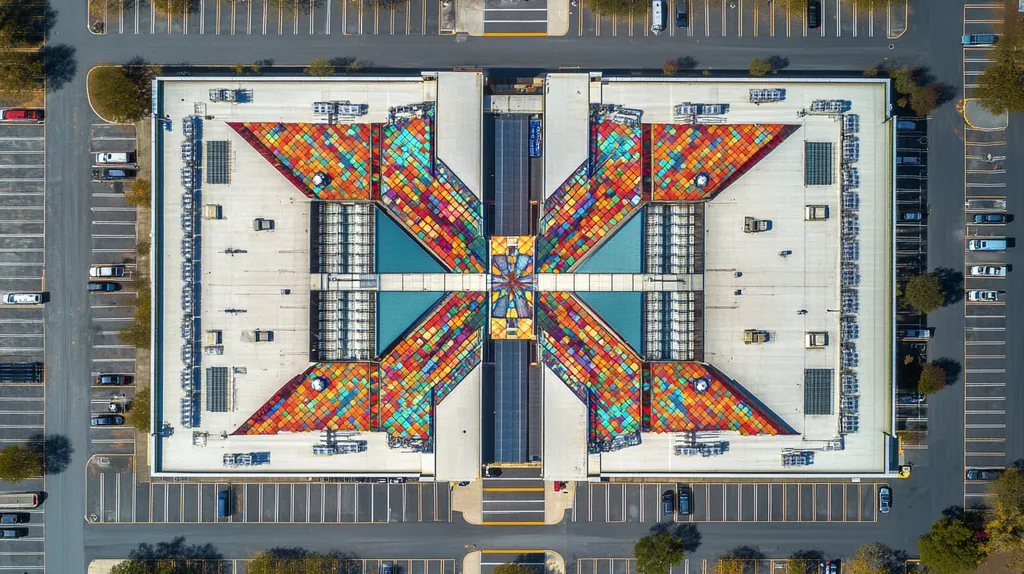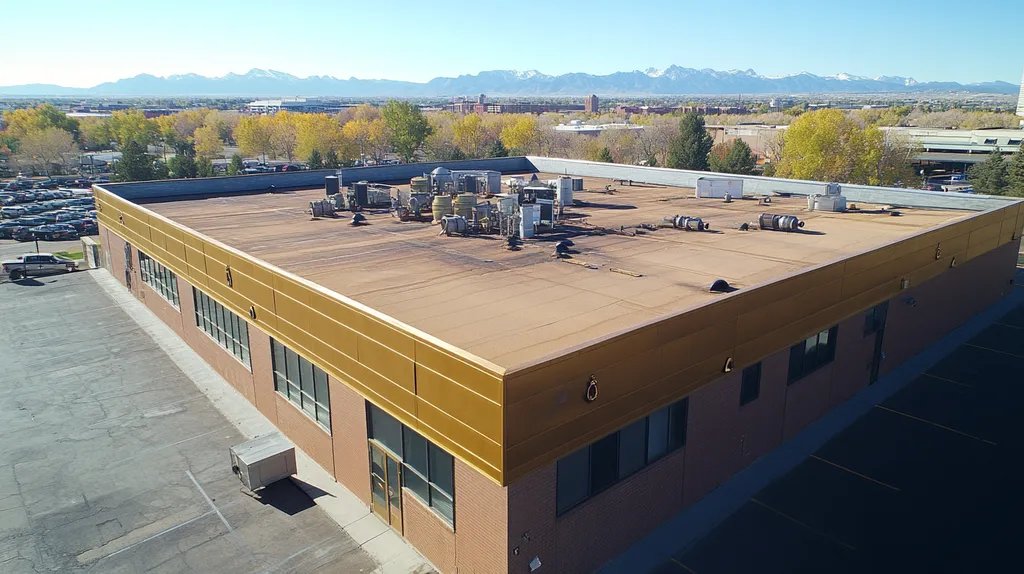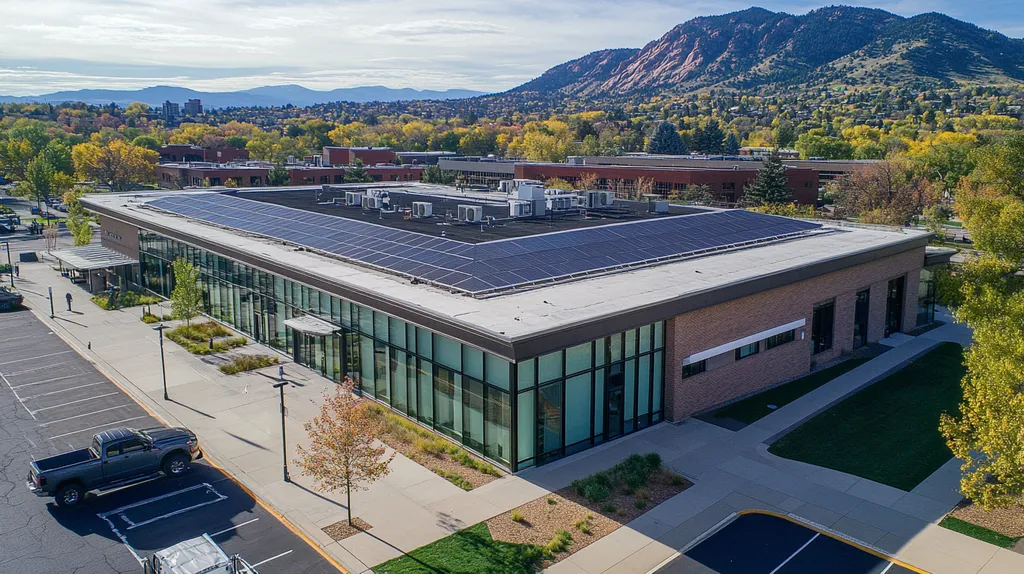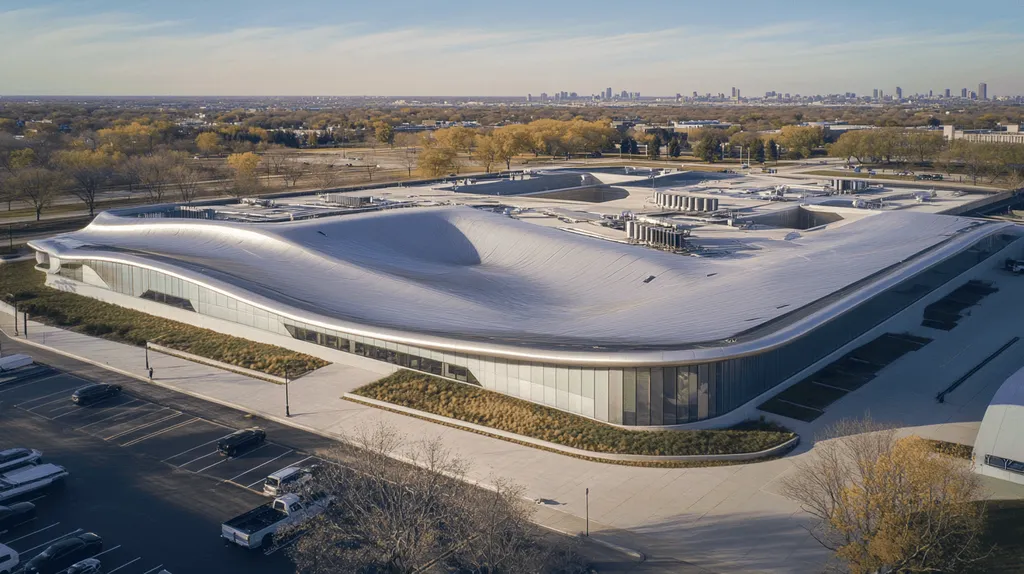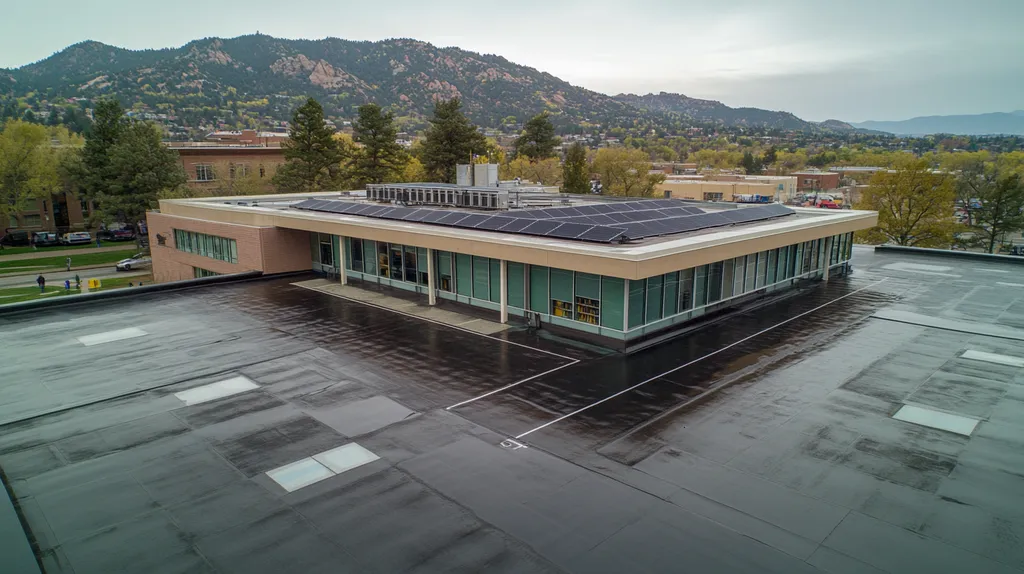With commercial buildings accounting for nearly 40% of total U.S. energy consumption, property owners face mounting pressure to optimize their roofing systems for maximum efficiency. Recent studies show that energy-efficient roofing materials can reduce cooling costs by up to 30% while extending roof lifespans by decades.
Yet many commercial properties continue using outdated roofing materials that waste energy and inflate operating costs. The growing array of high-performance options – from cool roofs to advanced insulation systems – creates both opportunities and complexities for decision-makers.
This comprehensive guide examines the critical factors in selecting energy-efficient roofing materials, including performance metrics, financial considerations, compliance requirements, and implementation strategies that drive measurable results.
SECTION 1: PERFORMANCE FACTORS
In an era where sustainability matters, commercial property owners are under pressure to adopt energy-efficient roofing solutions. With buildings responsible for nearly 40% of global energy consumption, roofing material selection plays a crucial role in reducing operational costs and environmental impact. Evaluating performance factors—such as energy efficiency, durability, and thermal insulation properties—can lead to significant long-term savings and improvements in building performance.
Energy Efficiency Metrics
When assessing roofing materials, energy efficiency metrics are vital. The Energy Star label serves as a strong indicator, showcasing superior reflective properties that help reduce heat absorption. A roof with a high solar reflectance index (SRI) can lower energy consumption by more than 20%, keeping buildings cooler and reducing stress on HVAC systems.
Equally important is the insulation value, measured by R-value, which indicates thermal resistance. A higher R-value represents better insulation, directly affecting energy requirements for heating and cooling. For example, a roof boasting an R-value of 30 can produce considerable savings compared to one with an R-value of 10.
Moreover, energy-efficient roofing materials may offer tax incentives and rebates, enhancing financial benefits while increasing property market value. By choosing the right materials that align with energy efficiency standards, property owners not only optimize their energy use but also comply with regulatory requirements.
Key Action Items
Durability and Weather Resistance
The durability of roofing materials is essential, especially with increasing extreme weather events. Property owners must evaluate how their roofing systems will hold up under challenging conditions. Materials like metal and modified bitumen offer exceptional resistance to wind, hail, and heavy rainfall, which minimizes the risk of costly repairs.
Durable roofing also demands less maintenance, allowing resources to be allocated elsewhere. For instance, TPO (thermoplastic polyolefin) roofs are known for their outstanding durability and reflective properties, making them a trusted choice for commercial settings. These roofs can last up to 30 years with minimal care.
Moreover, weather-resistant roofing helps prevent leaks and water intrusion, ensuring the integrity of the entire building. The longevity of roofing systems is further enhanced by their ability to resist mold growth and damage from UV exposure. Investing in durable materials not only protects property investments but also contributes to long-term sustainability.
Key Action Items
Thermal Insulation Properties
Thermal insulation properties are crucial for energy efficiency in roofing systems. The effectiveness of insulation directly determines a building’s energy consumption. Insulation materials such as spray foam and fiberglass excel at minimizing heat loss in winter and reducing heat gain in summer.
High-quality insulation forms a thermal barrier, stabilizing conditioned air within the building and lowering dependence on HVAC systems. With advanced insulation methods, buildings can enjoy energy savings of up to 50% compared to traditional options.
Enhanced thermal insulation not only promotes energy efficiency but also improves occupant comfort by maintaining consistent indoor temperatures. A comfortable working environment boosts employee satisfaction and productivity, delivering both tangible and intangible benefits to property owners.
Key Action Items
SECTION 2: FINANCIAL CONSIDERATIONS
For commercial property owners, rising energy costs make the financial aspects of roofing materials more critical than ever. Investing in energy-efficient roofing isn’t just about upfront expenses; it translates into substantial long-term savings. Research indicates that energy-efficient roofs can lower cooling costs by as much as 30%. This section delves into initial investments, potential savings, and ongoing maintenance expenses, empowering property owners to make informed decisions.
Initial Installation Costs
The upfront costs associated with energy-efficient roofing materials can exceed those of conventional options. However, viewing this expense as an investment rather than a hurdle is crucial. For example, while reflective roof systems may incur an initial expense of 10-20% more, their potential for significant savings over time is undeniable.
Budget-conscious property owners often feel apprehensive about these costs. It’s important to note that many manufacturers offer financing options and incentives to help ease the financial impact. Utilizing available rebates can also lead to considerable reductions in initial expenditures.
When calculating the installation costs, consider the added value that energy-efficient materials offer. Enhanced energy efficiency can increase property value, making these roofing solutions a smart financial choice. Moreover, planning strategically and hiring experienced contractors can help minimize expenses, ensuring the installation proceeds smoothly without unnecessary delays.
Key Action Items
Long-Term Energy Savings
One of the most significant financial advantages of energy-efficient roofing is the long-term energy savings it can provide. These roofs are designed to reflect more sunlight and absorb less heat, which translates to a reduced reliance on air conditioning. Properties can realize energy savings between 20-30%, leading to lower monthly utility bills.
For instance, a commercial building equipped with a reflective roof could save thousands of dollars annually on cooling costs. Over the years, these savings can effectively offset any additional costs incurred during the installation phase.
In addition, utilizing energy-efficient roofing materials can make a property eligible for green building certifications, further boosting its appeal to tenants or buyers interested in sustainability. Property owners should track their energy consumption before and after the new roofing’s installation to gather data supporting their energy-saving claims.
Key Action Items
Maintenance and Repair Expenses
Maintenance and repair costs are vital considerations in evaluating roofing materials and their financial impacts. Energy-efficient roofs may demand different upkeep strategies compared to traditional systems. While they might incur similar maintenance expenses, their durability often means fewer repairs are needed over time.
Reflective roofing technology is particularly resilient against environmental factors, leading to longer intervals between necessary repairs and thereby reducing long-term costs. Investing in high-quality materials typically includes extended warranties that protect the investment by covering select repairs and replacements as needed.
Implementing a proactive maintenance plan can further help in minimizing potential costs. Regular inspections can identify minor issues before they escalate, safeguarding the efficiency and longevity of the roofing system.
Key Action Items
SECTION 3: COMPLIANCE REQUIREMENTS
As awareness of environmental issues grows, adherence to roofing regulations transcends mere obligation; it’s essential for fostering energy-efficient building performance. Neglecting compliance can result in costly fines and heightened operational expenses. By understanding local building codes, energy efficiency mandates, and relevant certification programs, property owners can ensure that their roofing solutions actively support sustainability and energy savings.
Local Building Codes and Standards
Each municipality enforces its unique building codes and standards that dictate essential requirements for roofing materials and installation methods. These regulations aim to ensure safety, durability, and growing emphasis on energy efficiency. For example, California’s Title 24 mandates specific energy-saving measures for commercial roofing, illustrating the increasing standards.
Property owners should thoroughly familiarize themselves with their local regulations to avoid costly violations. Ignoring compliance can lead to fines and the need to retrofit or replace non-compliant roofs. By understanding these codes, decision-makers can make informed material choices from the outset, promoting compliance.
Involving local building inspectors early in the roof project can streamline the approval process. They offer valuable insights into compliance requirements and recent updates, which help save time and potentially secure funding or rebates from energy efficiency initiatives. Regular monitoring of evolving codes ensures continued compliance and the opportunity to adopt emerging, energy-efficient roofing technologies.
Key Action Items
Energy Efficiency Regulations
Energy efficiency regulations are playing an increasingly pivotal role in the commercial roofing arena, necessitating materials designed to minimize energy consumption. Programs like LEED (Leadership in Energy and Environmental Design) establish benchmarks that many commercial projects strive to meet. Adhering to these regulations not only boosts building performance but also promotes responsible environmental stewardship.
Various regions enforce energy codes that dictate specific thermal resistance (R-values) requirements for roofing products. Failure to meet these standards can lead to escalated energy bills and diminished overall building performance. Property owners that align their roofing choices with energy standards enjoy reduced operating costs and enhanced comfort for occupants.
Additionally, energy-efficient roofing materials may qualify property owners for state or federal incentives, including tax credits or rebates, significantly offsetting initial material costs. Collaborating with energy auditors can uncover the most effective strategies for compliance. Staying updated on changing energy efficiency standards enables property owners to avoid compliance hurdles and maintain a competitive market position.
Key Action Items
Certification and Accreditation
Certification and accreditation programs are crucial for validating the energy efficiency of roofing materials and systems. Initiatives like ENERGY STAR certify products that meet specific energy efficiency criteria, streamlining the selection process for property owners.
Accreditation from recognized organizations, such as the Cool Roof Rating Council, signifies that roofing products are designed to reflect more sunlight and absorb less heat, leading to significant cooling cost reductions for building owners. Investing in certified materials typically ensures better energy performance and long-term durability.
Additionally, actively pursuing certifications can improve a property’s marketability. Buildings that demonstrate a commitment to sustainability and energy efficiency through certification increasingly attract tenants and buyers with environmental concerns. Partnering with certified contractors reinforces adherence to best practices in roofing installation.
Key Action Items
SECTION 4: RISK MANAGEMENT
Effective risk management is essential for property owners and facility managers to protect their investments in roofing. With weather events becoming increasingly unpredictable, the potential for damage is substantial. A recent analysis revealed that weather-related incidents cost the commercial roofing industry an average of $600 million annually. By understanding key risk factors—such as weather-related damage, fire resistance, and material warranties—stakeholders can make informed decisions and ensure enhanced building safety.
Weather-Related Damage Mitigation
Weather-related damage poses a significant threat to commercial roofing systems. High winds, heavy rainfall, and extreme temperatures can compromise the integrity of roofing materials. For example, roofs located in hurricane-prone areas require specialized design considerations to endure severe conditions.
Utilizing impact-resistant materials can greatly reduce repair costs and extend the life of roofs. Roofing membranes made from TPO and PVC provide exceptional resistance to UV rays and extreme weather compared to traditional options. Implementing routine inspections before and after severe weather events helps identify vulnerabilities and ensures timely repairs.
A proactive approach, including the installation of effective drainage systems, can further mitigate the risks of damage. By preventing water pooling on roofs, building owners can avoid leaks and structural issues. Establishing regular maintenance schedules is crucial for detecting wear and tear before more significant problems arise.
Key Action Items
Fire Resistance and Safety
Fire safety is a critical yet often overlooked aspect of roofing risk management. Roofing materials differ in fire ratings, and selecting non-combustible options can significantly minimize the risk of fire damage. Notably, nearly 80% of commercial building fires originate on roofs or exterior walls, according to the National Fire Protection Association.
Choosing fire-resistant materials, such as modified bitumen or mineral-based membranes, can provide essential protection. Scheduled fire safety inspections help to identify potential hazards, ensuring compliance with local fire codes. Additionally, installing fire barriers and maintaining clear access for emergency services can further enhance safety measures.
Business owners should view fire-resistant roofing not just as a compliance requirement but as a strategic investment in risk reduction. Implementing a comprehensive fire safety plan, complete with employee training on emergency procedures, can bolster overall building safety and limit potential liabilities.
Key Action Items
Material Failure and Warranty
Material failure presents a significant risk that can lead to costly repairs and operational disruptions. Even top-quality materials are at risk if not installed correctly. A comprehensive warranty serves as essential protection against unexpected failures.
Manufacturers typically offer warranties ranging from 10 to 30 years, but it’s vital to understand their terms. Many warranties cover specific issues, such as material defects, leaving property owners exposed to other types of damage. Selecting manufacturers known for quality and support is crucial for ensuring reliability.
Property owners should inquire about warranty specifics, including coverage limits and claim processes. Additionally, ensuring that certified installers apply materials according to manufacturers’ guidelines can drastically reduce the risk of premature failure. Regular training for staff on maintenance and inspection procedures fosters awareness of potential failures before they escalate into significant problems.
Key Action Items
SECTION 5: OPERATIONAL PROCEDURES
In commercial roofing, following proper operational procedures is vital for maintaining energy efficiency and maximizing the lifespan of roofing systems. Poorly installed roofs can increase energy costs by up to 30%, underscoring the importance of installation and maintenance practices that protect investments in energy-efficient materials. This section details essential operational protocols to enhance the performance of roofing systems.
Installation and Application Guidelines
Successful installation is the foundation of any energy-efficient roofing project. Adhering to manufacturer specifications is crucial, as proper flashing installation significantly reduces the risk of water intrusion and enhances thermal performance.
Engaging qualified professionals for installations minimizes errors that could lead to premature wear and increased energy demand, jeopardizing the benefits of energy-efficient materials. Utilizing high-quality adhesives and sealants during the application further bolsters the roof’s resilience against environmental factors.
Investing in certified roofing contractors who stay updated on the latest energy-efficient materials ensures superior application, which directly influences the roof’s durability and long-term performance.
Key Action Items
Regular Maintenance and Inspection
Routine maintenance is crucial to sustaining the integrity and efficiency of roofing systems. Regular inspections can help detect issues such as membrane degradation or flashing failures before they escalate into costly repairs. The National Roofing Contractors Association recommends bi-annual inspections to monitor the roof’s condition.
Consistently removing debris from the roof and drainage systems prevents water pooling, which can lead to thermal inefficiencies and structural damage. This proactive approach ensures unobstructed drainage, maintaining optimal energy performance.
Furthermore, addressing minor issues quickly during inspections can save significant costs over time by preventing extensive damage that could compromise energy efficiency. A structured maintenance schedule will extend the roof’s lifespan while preserving its energy-saving capabilities.
Key Action Items
Repair and Replacement Protocols
When repairs are necessary, adhering to industry best practices is critical to maintaining energy efficiency. The use of compatible patching materials prevents thermal bridging, ensuring the roof’s energy performance remains unaffected.
Preparing for complete roof replacement is also important. Choosing high-performing materials during these cycles presents an opportunity to enhance energy efficiency. The impact of reflective or insulated materials can significantly reduce HVAC loads and energy costs.
Careful documentation of repairs and replacements is essential for tracking a roof’s performance. This information serves as a valuable reference for future maintenance and upgrade decisions. Additionally, establishing a budget for repairs and replacements is vital for effective financial planning and preventing emergency costs from arising.
Key Action Items
SECTION 5: OPERATIONAL PROCEDURES
In the world of commercial roofing, adhering to proper operational procedures is vital for maintaining energy efficiency and extending the lifespan of roofing systems. Studies reveal that poorly installed roofs can increase energy costs by as much as 30%. Implementing optimal installation and maintenance practices is not just important; it’s essential for protecting investments in energy-efficient materials. This section outlines the crucial operational protocols necessary for achieving the best performance from roofing systems.
Installation and Application Guidelines
Effective installation is the keystone of any energy-efficient roofing project. Following manufacturer specifications is essential, as proper flashing installation helps prevent water intrusion and enhances thermal performance.
Engaging qualified professionals for installations helps mitigate errors that could lead to premature wear and increased energy demand, undermining the advantages of energy-efficient materials. High-quality adhesives and sealants during application also play a crucial role in fortifying the roof against environmental factors.
Investing in certified roofing contractors conversant with the latest energy-efficient materials ensures superior application, which maximizes the roof’s long-term performance.
Key Action Items
Regular Maintenance and Inspection
Routine maintenance is crucial for upholding the integrity and efficiency of roofing systems. Regular inspections can detect issues like membrane degradation or flashing failures before escalating into costly repairs. The National Roofing Contractors Association recommends bi-annual inspections to assess the roof’s condition.
Consistently cleaning debris from the roof and drainage systems helps prevent water pooling, which can lead to thermal inefficiencies and structural damage. Maintaining unobstructed drainage promotes optimal energy performance.
Additionally, addressing minor issues promptly during inspections can save significant costs over time by preventing extensive damage that may compromise energy efficiency. A structured maintenance schedule will extend the roof’s lifespan while preserving its energy-saving capabilities.
Key Action Items
Repair and Replacement Protocols
When repairs are necessary, it’s critical to adhere to industry best practices. Using the correct materials and techniques ensures that energy efficiency is preserved. For instance, using compatible patching materials can prevent thermal bridging and maintain energy performance.
Property owners should also prepare for the eventuality of complete roof replacement. Selecting high-performing materials during replacement offers an opportunity to further enhance energy efficiency. The impact of reflective or insulated materials can significantly reduce HVAC loads.
Thorough documentation of repairs and replacements is essential for tracking a roof’s performance over time. This information aids in making informed decisions about future maintenance and upgrades. Establishing a budget for repairs and replacements is also vital for effective financial planning and to avoid emergency costs.
Key Action Items
Moving Forward
With energy costs projected to rise 30% over the next decade, commercial property owners can no longer afford to delay upgrading to energy-efficient roofing systems. Studies show that buildings with optimized roofing materials reduce their carbon footprint by up to 40% while saving thousands in annual operating costs.
The path forward requires thoughtful integration of performance metrics, financial planning, and compliance requirements. Property owners must prioritize materials that deliver measurable efficiency gains while meeting increasingly stringent building codes.
By implementing comprehensive maintenance protocols and leveraging emerging roofing technologies, facilities can maximize both sustainability and ROI. The future of commercial building performance hinges on making informed roofing decisions today.
The stakes are clear: those who embrace energy-efficient roofing solutions will lead the transition to high-performance buildings, while those who delay risk falling behind in an evolving regulatory and economic landscape.
FREQUENTLY ASKED QUESTIONS
Q. What performance factors should I consider for my commercial roof?
A. When evaluating roofing materials, consider energy efficiency, durability, and insulation properties. Energy-efficient roofs can significantly reduce operational costs while improving overall performance.
Q. How can I assess the financial impact of an industrial roof?
A. Analyze initial installation costs, long-term energy savings, and maintenance expenses. Investing in energy-efficient roofing typically leads to lower utility bills and potential financial incentives.
Q. What compliance requirements exist for commercial roofing?
A. Familiarize yourself with local building codes and energy efficiency regulations. Following these requirements ensures sustainability and avoids costly fines while enhancing overall building performance.
Q. How can I mitigate weather-related risks for my commercial roof?
A. To reduce weather-related damage, use impact-resistant materials and conduct regular inspections. Implementing effective drainage systems helps prevent water pooling and potential structural issues.
Q. What operational procedures are necessary for energy-efficient roofing?
A. Prioritize proper installation, scheduled maintenance, and timely repairs. Adhering to these procedures ensures optimal performance and longevity, maximizing the benefits of energy-efficient roofing systems.
Q. What additional considerations exist when selecting industrial roofing materials?
A. Consider the environmental impact of materials, local climate conditions, and lifecycle assessment. Choosing sustainable options contributes positively to both community well-being and long-term roof performance.
Q. How can I ensure the longevity of my commercial roof?
A. Establish a proactive maintenance schedule, conduct bi-annual inspections, and use quality materials during installations and repairs. Consistent attention to these areas extends the lifespan of your roofing system.

